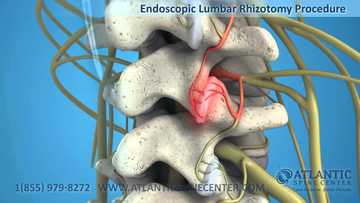Endoscopic Spine Surgery
Diagnostic Procedures
Pain Management Procedures
Traditional Spine Fusion Surgeries
Mini Spine Fusion and Spine Disc Replacement
Endoscopic Facet Rhizotomy
The Endoscopic Facet Rhizotomy procedure is a true minimally invasive spine surgery used to deaden affected nerves causing chronic back and neck pain.
With the guidance of x-rays, our endoscopic rhizotomy is completed without damaging surrounding muscles or soft tissue like traditional spine surgery.
multimedia
The advantages of an endoscopic facet rhizotomy
Advantages of endoscopic facet rhizotomy surgery include the following:
- Minimally Invasive
- Short recovery
- High Success rate
- Minimal or no blood loss
- Preservation of spinal mobility
- Small incision and minimal scar tissue formation
- Same day surgery with no hospitalization (outpatient procedure)
Conditions endoscopic facet rhizotomy treats
Conditions Lumbar Endoscopic Facet Rhizotomy treats:
- Chronic low back pain
- Facet hypertrophy
- Facet joint arthritis
- Facet joint injuries
- Failed back surgery syndrome
- Whiplash syndromes
Conditions Cervical Endoscopic Facet Rhizotomy treats:
- Chronic neck pain
- Facet hypertrophy
- Facet joint arthritis
- Facet joint injuries
- Failed back surgery syndrome
- Whiplash syndromes
Endoscopic facet rhizotomy procedure
The patient is brought to the operating room and is administered a local anesthetic and intravenous sedation. The surgical targets are marked at the skin level under fluoroscopic guidance (x-rays), and a small cut (about 7 mm) is made on the skin. Then, a tube is inserted to the target. The endoscope is then placed through the tube, and the small nerve branches (medial branch) from the nerve root are identified.
A laser is then used to deaden the nerve branches, which only have a sensory function. Finally, the tube is removed, the incision is closed with a stitch or two, and the endoscopic facet rhizotomy is complete. Upon completion, the patient is encouraged to walk around and is free to leave the surgical center with a companion the same day. After a follow-up visit with the surgeon the next day, the patient can go home for a quick recovery.
Endoscopic facet rhizotomy risks
As with any other type of surgery, endoscopic facet rhizotomy has some risks. The risks include excess bleeding, local infection, and nausea or vomiting. Usually, to perform this procedure, anesthesia is used, so it can also result in some issues and post-anesthesia complications.
Also, you can experience some sensory changes like numbness or sensitivity after the surgery.
Moreover, this procedure doesn’t offer a 100% success rate. Some patients struggle with pain even after undergoing rhizotomy. The pain can stay the same after the surgery or disappear for a while and then gradually come back.
If the nerve regrew or the pain wasn’t relieved after the first rhizotomy, your doctor can recommend a second rhizotomy or some other type of invasive treatment.
Endoscopic facet rhizotomy side effects
Generally, endoscopic facet rhizotomy is a safe procedure with few side effects and risks. Complications after the surgery are also uncommon.
Depending on the patient’s health, diagnosis, and the procedure’s success, a patient who underwent rhizotomy can experience weakness or dizziness, so it is usually advised not to drive by yourself after the procedure. You can also feel chills and fever or have swelling at the injection site.
As already mentioned, some numbness can be observed after the procedure, but it usually lasts several hours. Remember that if the symptoms stay for more than 2-3 hours, you should contact your healthcare provider for additional tips.
Recovery after endoscopic facet rhizotomy
Proper preparation for this procedure is vital. As in most patients, intravenous sedation is used. You shouldn’t eat or drink the morning before the procedure. As weakness and dizziness are typical side effects of the rhizotomy, you shouldn’t drive home alone, so you should arrange a transfer from the hospital beforehand. For instance, ask a friend to drive you. Also, make sure to inform your medical team about all the medications you typically take, as some of them can be better avoided before rhizotomy. Aspirin and other blood thinning medications are examples of such medications that shouldn’t be taken before invasive procedures.
The recovery after rhizotomy is quite fast, but you’ll probably feel some discomfort after the procedure. Usually, patients are advised to walk the same day after the rhizotomy. Many patients feel pain relief after the surgery, recover quickly, and can return to work about a week after the procedure. In some patients, it takes longer to heal.
All patients should avoid twisting and lifting heavy things after the surgery. Be in contact with your medical team to get a personalized recovery plan.
Remember that improving your lifestyle can speed your recovery. For instance, smoking slows tissue recovery, so quitting can be a good idea. You can also learn some gentle stretches and exercises to promote bone and muscle health, but make sure you discuss this with your doctor. Maintaining a healthy weight and having a well-balanced diet with enough vitamin D, Zink and Calcium are essential to muscular-skeletal health, as drinking plenty of water.

